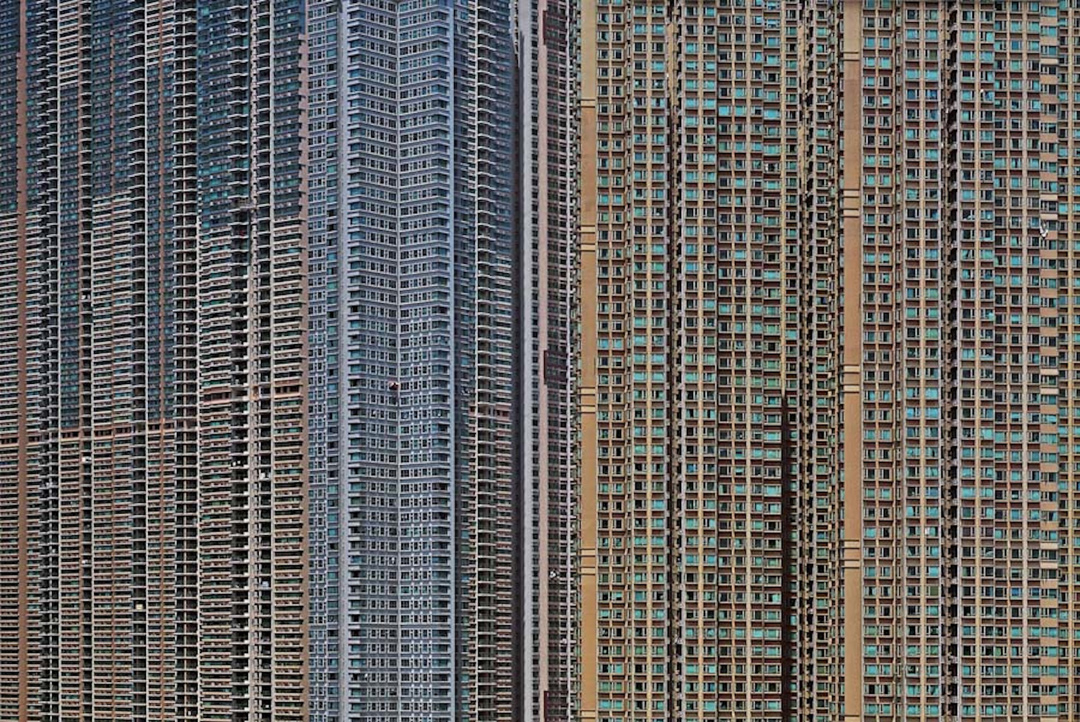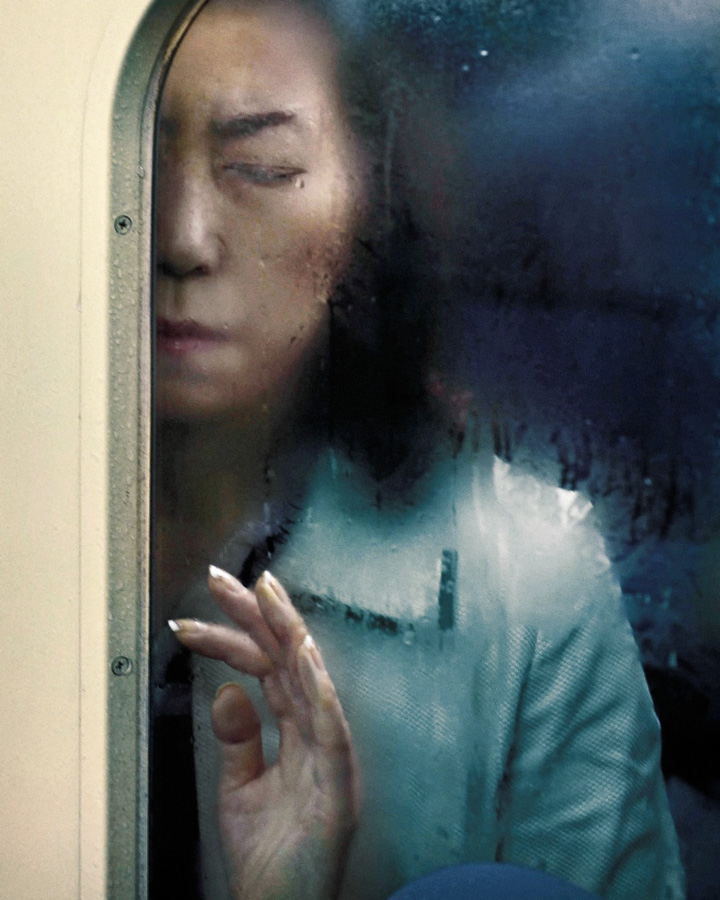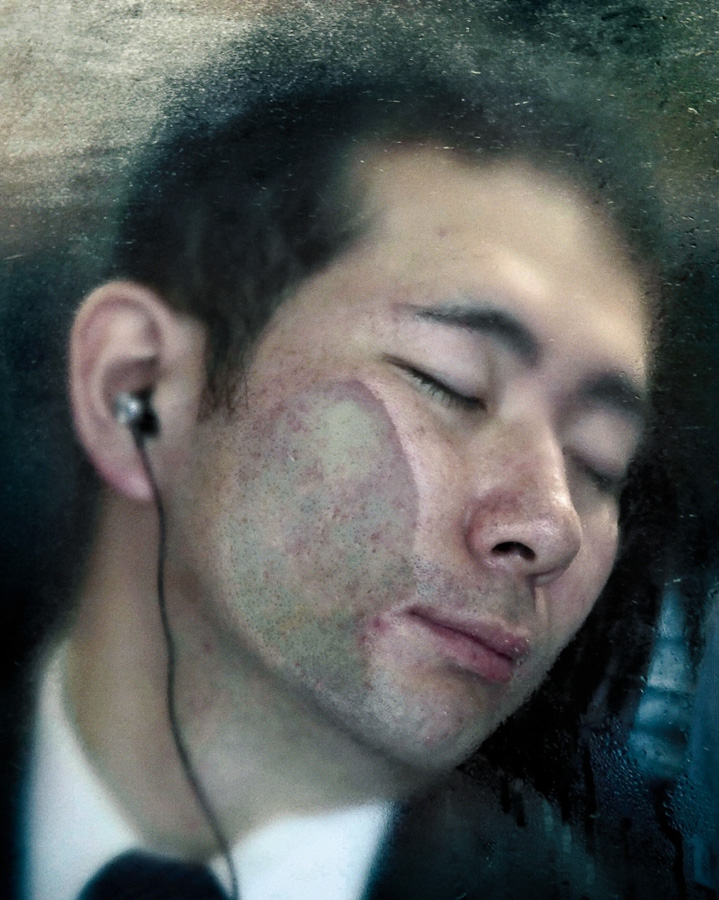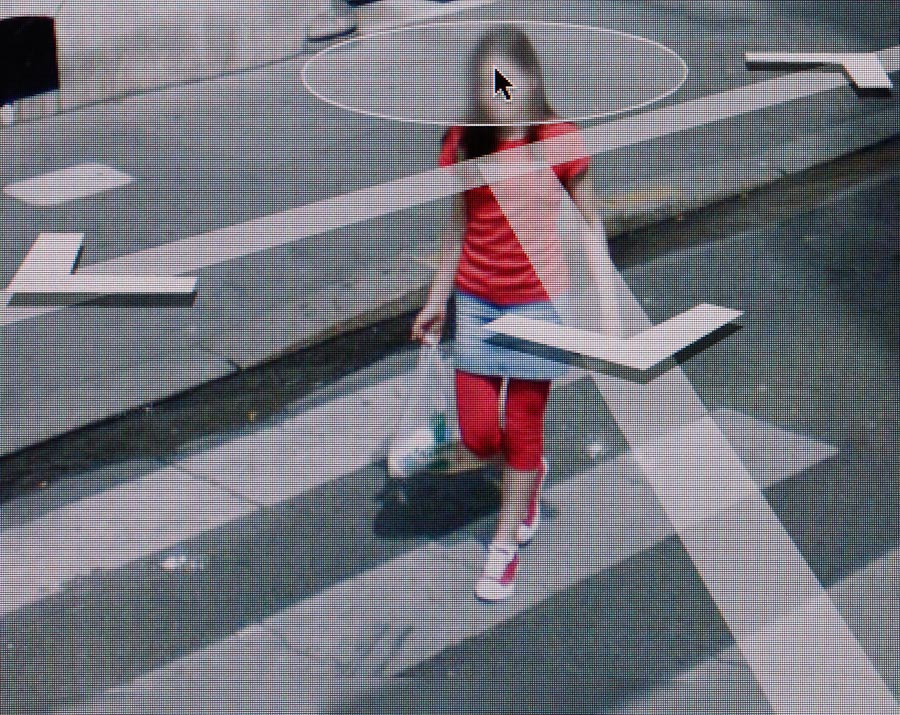
Michael Wolf – aus Architecture Of Density
Diese Interview wurde 2011 im Rahmen einer Buchpräsentation bei 25books, Berlin, auf englisch geführt und ursprünglich auf der Seconds2Real Website veröffentlicht.
Christian Reister: When and how did you start photographing?
Michael Wolf: I started taking photographs when I was thirteen or fourteen years old. I lived in America and my parents gave me a camera. I just started experimenting and I found that I really enjoyed it. I enjoyed taking pictures and I enjoyed even more going into the dark room and developing the films, seeing the pictures come up and editing and cropping things.
In 1972 a friend of my father came for a visit. He saw my pictures and he said „I teach at the Folkwang School in Essen and there is a very famous professor named Otto Steinert“, whom I’ve never heard of before. And he said „Why don’t you apply?”. That’s exactly what I did and six months later I received a postcard from the admissions office that said “You’ve been admitted to study photo journalism with Otto Steinert”. So I went over there in October 1973. I never went there with the intention of becoming a photo journalist. I went there to take a time-out year from studying in California. But I suddenly realised that photo journalism was such an interesting thing to do. It gave me an excuse to go out and sniff into other people’s experiences and lives. So I thought „Wouldn’t it be great to do this and be able to earn money with it?”
Christian Reister: …but after years of photo journalism work you moved on to the art world…
Michael Wolf: Yes, I haven’t done an assignment since 2003 when I decided to quit doing editorial assignment work and only to work on my own projects. The reason for this was that the conditions for working as a photo journalist have changed tremendously since the year 2000. Until the year 2000 when there was the big dotcom crash, there were still very good assignments to get. You could work for Stern magazine or GEO for four, six or eight weeks on a topic, travel extensively, taking an assistant. So you could really go into depth. That was a very rewarding thing to do. But after the dotcom crash the magazines lost advertising customers and suddenly realised that they had to save. So the assignments became shorter, you had much less time to work on them and you had very clear art directors who told you “We need three pictures and that’s it”. So while I was getting older and more demanding in what I wanted to do, what I was doing was actually getting stupid and boring. So I decided I don’t want to end my life this way and rather do something else. For me the alternative was to only work on my own projects. But then the question is how to earn money with your own projects. The only way I found for myself is through the art world. Find galleries and sell your work at the art fairs through gallerists. I was fortunate enough that this way worked out for me.


aus: Tokyo Compression
Christian Reister: Let’s talk about your work Tokyo Compression which is very successful as a book and in exhibitions as well. It deals with the daily hell in the subway of Tokyo. How long did you work on it and what triggered you to do it?
Michael Wolf: The first time that I became aware of this situation was in 1997, I think. I was working on an story for Stern magazine in Tokyo. This is how I happened to be on this one train station. The peculiar thing about this station is that there is only one track and not two. So when the people get in on one side of the train I can get right up next to the window of the other side. There’s no track separating me from the train. So I took a series of five pictures at that time. When I got back to Hongkong and looked at the developed Kodachromes they were so powerful, the way these people were looking out of the window so I filed them away in my folder for future reference with topics I want to do at some point. In 2008/2009 I went back and spent a total of thirty days there. Always from Monday to Friday, always during rush hour in the morning from 7.30 until about 8.45. Every thirty seconds a train would roll in, I would take my pictures and at 8.45 I would go back to the hotel.
Christian Reister: You worked very close, but in the book the images are cropped, right?
Michael Wolf: Yes, I worked extremely close. I could get up to 3 or 4 inches away. In the beginning I wasn’t really sure how I was going to solve this problem conceptionally. I had photographed a lot of total windows and inside of each window of the train there would be three, four or five faces. In-between I would go up closer. When I was editing the project and thinking about how I was going to show it and how I was going to publish it I realized that conceptionally it would work best if they are all cropped very close to the faces. So I basically took every picture and set my crop tool to 8 by 10 inches. Of course some of the files are a bit smaller and I would need to make a big – say 30 by 40 inch – print. But what I realised is that by printing them with an inkjet printer on a hahnemühle rag paper you get an almost painterly quality which really endorses what the images have to say.
Christian Reister: Another work of yours that is extremely successful is your Google Street View project. What was your intention for taking photographs from a computer screen and where do you think is the difference in your approach to other artists working with Google Street View like Jon Rafman or Doug Rickard?
Michael Wolf: First of all, let’s get to the genesis of me photographing Google Street View. This happened when my wife moved to Paris in 2008 after we had been living in Hongkong for 16 years. I realised quite quickly that Paris was visually a very boring city for me. I was very unhappy. I had no idea what to photograph. The problem was on the one hand that Paris has been photographed millions of times and there are so many clichés out there that I felt overwhelmed. The other problem is that the law in France is quite strict. You can not photograph people in groups less than five without risking a lawsuit. So in August 2008 I had the first idea to look at Street View and to use this new technology to take a different picture of Paris than that which had existed.

Michael Wolf – from Paris Street View
Until then I haven’t been aware of anyone’s work – it was when I put my work up on my website that friends send me a few links, e.g. to Jon Rafman. I’ve been following his work but I think our work is entirely different. He is usually using the whole street view scene including all the tool bars so it’s more a documentation of what Google sees. What I’m doing is interpreting the Google pictures making my own narratives and my own pictures out of them by doing extreme crops, sometimes of only a foot or of a hand disappearing behind a tree. That’s one approach I take. Another one is that I work in typologies as I do all the “Fuck Yous” as a comparative series or a whole series of portraits of people whose faces have been blurred by the Google technology.
So I think there are many of different approaches to Street View just as there are many different approaches to any photographic project.
Christian Reister: You are featured in the Street Photography Now book. Do you consider yourself a street photographer? What does that term mean to you?
Michael Wolf: I don’t consider myself a street photographer at all. I come from photo journalism which of course has many aspects of street photography but I think the traditional street photographer would be someone like Garry Winogrand who basically walked the streets and looked for interesting moments which he could photograph. I dont think I’ve walked the streets for random images in at least ten years.
On the other hand you could call my Google Street View project a form of street photography and of course it is very directly tied to the street because what Google is doing is it’s only photographing everything one can see from the car. So in that sense I would say I’m a very contemporary virtual street photographer.
Christian Reister: You said that you didn’t have an idea what to photograph in Paris because there are millions of pictures already taken in Paris. Do you think this is a key problem in street photography or in photography in general – the fact that “Every picture has been done before”?
Michael Wolf: I think we have to be very careful because iconic pictures tend to ingrain themselves in the collective consciousness of all photographers and it’s very easy to fall into a trap and repeat things. I remember when I was studying I fell in love with cars parked which had a huge tarp over them. And of course Robert Frank was the first person who took this picture and whenever you do something like that, its derivative. There are thousands of examples like that. The question is how we can discover new images. That’s the challenge what every artist goes through. You always have to evaluate what you are doing and measure it against what has been done because to simply repeat something is a boring exercise. It’s a much greater challenge to find a new way to express things or pushing the idea of photographs and their limits farther.
For me for instance in Hongkong I had the good fortune of photographing my Architecture Of Density series in a way which hadn’t been done before that rigorously. I cropped every building that there was no sky and no horizon so the result was that you had a very tight picture which could be credibly large because you had no idea where the building ended on the sides and on the top. If you looked at it from far away hanging on a wall it looked very abstract. But when you came up close you suddenly realised that this was a huge building and it had life inside. You saw the details on it so it suddenly became a statement on how we live in mega cities. The good fortune on this was that I found this formal solution which made these pictures suddenly look different and interesting and I think one can find the same in street photography. One just has to go out and do it.
A good example concerning the image of Paris is William Eggelston who came here and did his Paris book with Steid. This is suddenly a totally different view on Paris that I think is very exciting. Details of plastic bags and things like that. So you see – you can always develop something further.
When I studied in the Seventies with Otto Steinert I was h4ly influenced by the formal classics like Eugene Smith or Catier-Bresson. These were very important people for us. But then along came someone like Eugene Richards who did this incredible work which was formally very different – everything was mixed up and you had no idea really where the middle point of the photograph was and thereby it became much more interesting. Someone had suddenly discovered a new way of looking and a new way of framing things and thereby people looked again!
Then you had Sebastiano Salgado, then James Nachtway – you have a whole bunch of photographers who make it their trademark to have a very unique style and try to intentionally look very different to anyone else because you need to have a trademark that makes you look different to be successful.
Christian Reister: Which comtemporary or emerging photographers impress you?
Michael Wolf: I don’t care about the age of a photographer, I just look if their work interests me or not. I like the works of Sebastian Girard, Olaf Unverzart and Raimond Wouda.
Christian Reister: Any new projects intended that you could tell us about?
Michael Wolf: At the moment I still have this huge amount of work to do with Street View. I’m planning a book in 2012. It’s quite a challenge to sit in front of the monitor every day and photograph for three or four hours so I’m doing it piece by piece. Otherwise I’m always going back and forth between Europe and Asia and there are several things I’m working on in China. But that will be a surprise.
Christian Reister: Thank you very much, Michael, for taking your time for this interview.
Michael Wolf wuchs in Kalifornien auf, studierte in Berkeley und an der Folkwang-Hochschule in Essen. 1994 ging er für den Stern als Fotoreporter nach Hongkong. Wolf lebte zehn Jahre in China. Seit einigen Jahren lebt er mit seiner Familie in Paris. Er arbeitet als freier Fotograf. (Quelle: wikipedia)
Michael Wolf hat zahlreiche Bücher veröffentlicht, vor allem bei Peperoni Books.
left: Michael Wolf – Photo by Christian Reister
